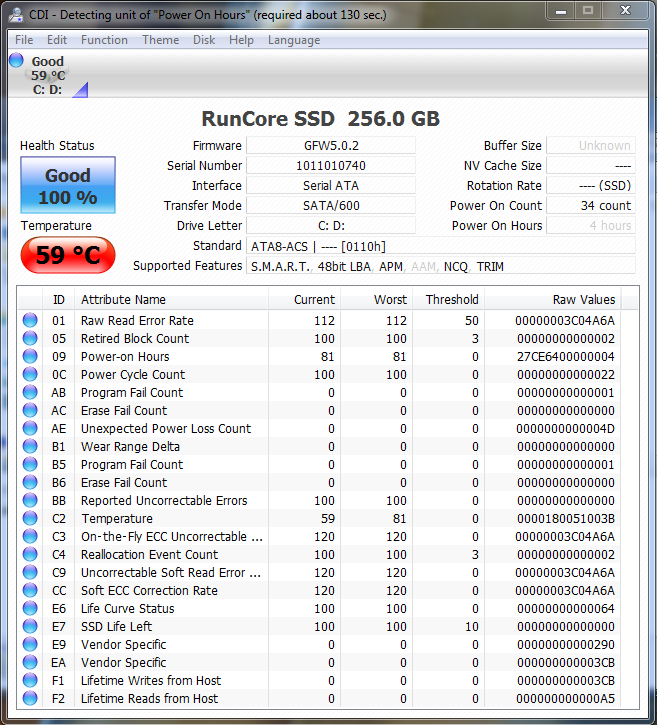Crystal Disk Info provides some excellent information about the SSD itself to include its health, product information, ‘power on’ information as well as the characteristics of the SSD. We can see that the Runcore Rocket Air is capable of TRIM as it is not greyed out, much like AAM.
It is also good to see that Runcore has included several SMART attributes, however, we didn’t think the temperature was correct in this software as the SSD was just above being cool to the touch in the MBA.
ATTO Disk Benchmark is perhaps one of the oldest benchmarks going and is definitely the main staple for manufacturer performance specifications. ATTO uses RAW or compressible data and, for our benchmarks, we use a set length of 256mb and test both the read and write performance of various transfer sizes ranging from 0.5 to 8192kb. Manufacturers prefer this method of testing as it deals with raw (compressible) data rather than random (includes incompressible data) which, although more realistic, results in lower performance results.
Although these results were definitely in the SATA 3 range, they weren’t close to the specifications of 488MB/s read and 501MB/s write and definitely weren’t typical of what we has seen in similar ‘LSI SandForce Driven’ SSDs. To be sure, we decided to pull the SSD and attach it to our other MBA, running a Secure Erase and then reinstalling the system. The final result was the same.
CRYSTAL DISK BENCHMARK VER. 3.0 X64
Crystal Disk Benchmark is used to measure read and write performance through sampling of highly compressible data (oFill/1Fill), or random data which is, for the most part, incompressible. In the Runcore Rocket Air, we have displayed testing using highly compressible data on the left, compared to that of incompressible on the right.

 The results we see with CDM are similar to that of ATTO and the low 4k random write scores are typical of all Mac platform SSD testing. You will notice the capacity of 120GB which is because our Mid-2011 MBA is running a dual boot with OSX Mountain Lion and Windows 7. Unfortunately, the form factor of this SSD prevents us from testing it on our typical test bench or even our 2012 MBA.
The results we see with CDM are similar to that of ATTO and the low 4k random write scores are typical of all Mac platform SSD testing. You will notice the capacity of 120GB which is because our Mid-2011 MBA is running a dual boot with OSX Mountain Lion and Windows 7. Unfortunately, the form factor of this SSD prevents us from testing it on our typical test bench or even our 2012 MBA.
 The SSD Review The Worlds Dedicated SSD Education and Review Resource |
The SSD Review The Worlds Dedicated SSD Education and Review Resource | 

It seems like many of us are on our second or third mSATA SSD and using a mSATA-to-2.5inch converter inside a 2.5inch enclosure is a waste of space. Have you seen a USB3-to-mSATA enclosure that is just as sleek as that aluminum external adapter?
No I don’t know of any other than Mac specific ones as we have seen from Runcore and OWC, both being blade style specific and not mSATA. MyDigitalSSD markets one we did a short piece on but it is an external that is the size of a SSD
Hi, where I can buy this SSD?
It is still to be released in typical outlets and I might contact Runcore.
Not sure if you still have the drive, but if so, any chance you might be able to examine battery life as compared to the stock SSD? One of the critiques of the Aura was that it had a higher power draw than the stock SSD. Thanks! 🙂
Negative sorry.
Will it fit the new imac 27′?
and will we have the possibility to make fusion drive with it?
Any update on this blade SSD compatibility with Asus zenbook and prime series laptops and also on its poor performance issue not meeting the manufacture’s published data?
Will it work with X1 Carbon model 2012/2013